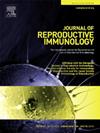RLR pathways in pregnancy: Guardians of antiviral immunity and mediators of inflammation-driven complications
IF 2.9
3区 医学
Q3 IMMUNOLOGY
引用次数: 0
Abstract
Pregnancy demands dynamic immune adaptations to support implantation, fetal growth, and labor while maintaining maternal-fetal tolerance. The immune profile shifts from pro-inflammatory during implantation to anti-inflammatory in mid-pregnancy, reverting to inflammation at labor onset. Key immune cells like NK cells, macrophages, dendritic cells, and T cells dominate the decidua, guiding successful placental development. These immune cells express pathogen recognition receptors (PRRs) such as Toll-like receptors (TLRs), RIG-I-like receptors (RLRs), Nod-like receptors (NLRs), and C-type lectin receptors (CLRs) at the maternal–fetal interface and detect pathogen-associated molecular patterns (PAMPs) during pathological conditions. Among them, RIG-I-like receptors (RLRs), including RIG-I and MDA5, are expressed in syncytiotrophoblasts and cytotrophoblasts, where they sense RNA viruses like Zika and dengue during pregnancy. RLR signalling in pregnancy is modulated by hormones like estrogen and glucocorticoids. Cellular metabolic product lactate also regulates this signalling. The RLR signaling pathway is crucial for antiviral defense at the maternal-fetal interface, but its dysregulation can lead to complications like preeclampsia and preterm birth. Therapeutic targeting of RLR components and interferon regulators offers promising treatment avenues. Diagnostic biomarkers like circulating RLR molecules may aid in early detection of pregnancy disorders. Overall, RLR signaling presents both therapeutic and diagnostic potential in managing inflammation-associated pregnancy complications.
妊娠中的RLR通路:抗病毒免疫的守护者和炎症驱动并发症的介质
妊娠需要动态的免疫适应来支持着床、胎儿生长和分娩,同时维持母胎耐受性。免疫谱从植入期间的促炎转变为妊娠中期的抗炎,在分娩时又恢复为炎症。关键免疫细胞如NK细胞、巨噬细胞、树突状细胞和T细胞主导蜕膜,引导胎盘成功发育。这些免疫细胞在母胎界面表达病原体识别受体(PRRs),如toll样受体(TLRs)、rig - i样受体(rlr)、nod样受体(NLRs)和c型凝集素受体(CLRs),并在病理状态下检测病原体相关分子模式(PAMPs)。其中RIG-I样受体(rlr),包括RIG-I和MDA5,在合胞滋养细胞和细胞滋养细胞中表达,它们在怀孕期间感知寨卡病毒和登革热等RNA病毒。妊娠期的RLR信号由雌激素和糖皮质激素等激素调节。细胞代谢产物乳酸也调节这一信号。RLR信号通路对母胎界面的抗病毒防御至关重要,但其失调可导致子痫前期和早产等并发症。靶向治疗RLR成分和干扰素调节剂提供了有希望的治疗途径。像循环RLR分子这样的诊断性生物标志物可能有助于早期发现妊娠障碍。总的来说,RLR信号在治疗炎症相关妊娠并发症方面具有治疗和诊断潜力。
本文章由计算机程序翻译,如有差异,请以英文原文为准。
求助全文
约1分钟内获得全文
求助全文
来源期刊
CiteScore
6.30
自引率
5.90%
发文量
162
审稿时长
10.6 weeks
期刊介绍:
Affiliated with the European Society of Reproductive Immunology and with the International Society for Immunology of Reproduction
The aim of the Journal of Reproductive Immunology is to provide the critical forum for the dissemination of results from high quality research in all aspects of experimental, animal and clinical reproductive immunobiology.
This encompasses normal and pathological processes of:
* Male and Female Reproductive Tracts
* Gametogenesis and Embryogenesis
* Implantation and Placental Development
* Gestation and Parturition
* Mammary Gland and Lactation.

 求助内容:
求助内容: 应助结果提醒方式:
应助结果提醒方式:


